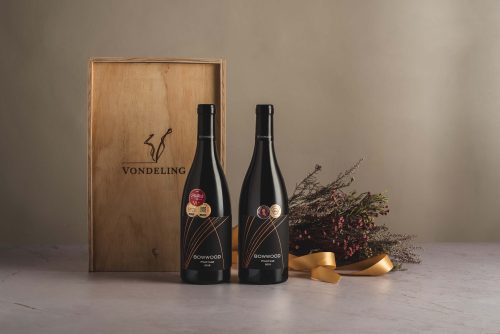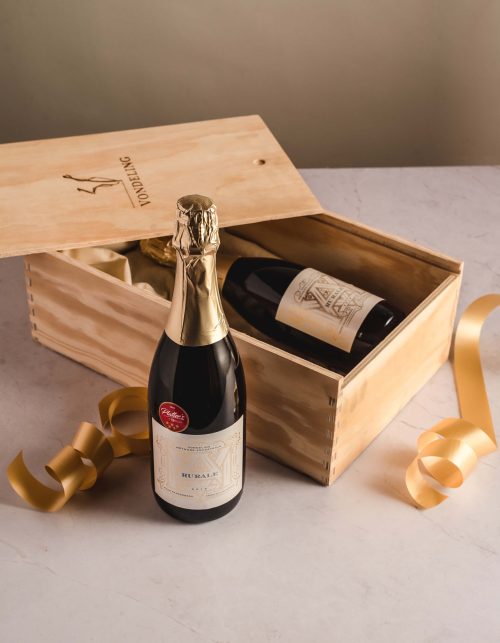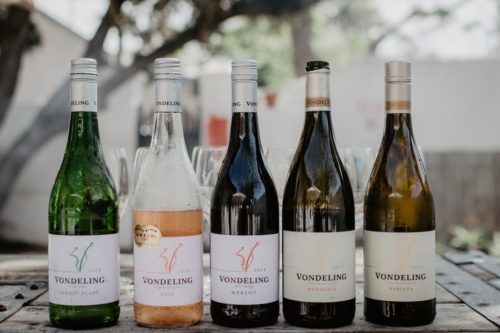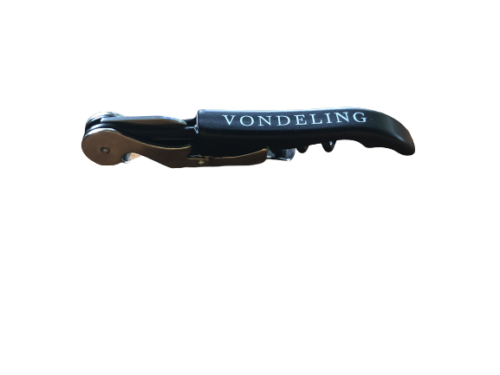-
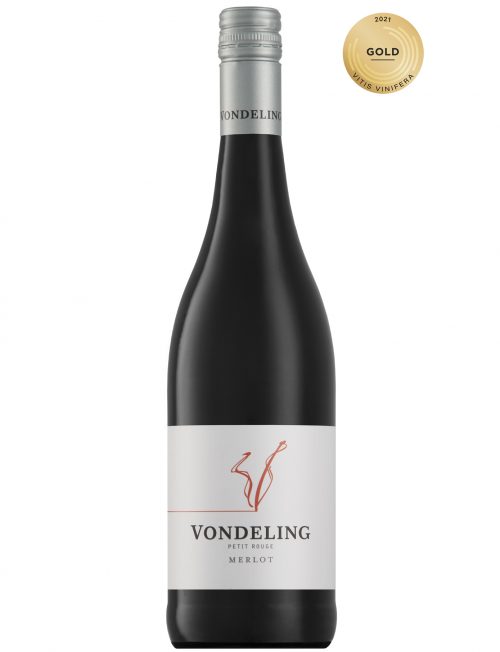 (100% Merlot) VINEYARDS The Merlot vineyard used in this wine is planted in a combination of well-weathered granite soils and beautiful “koffie klip” (shale) slopes. They are South-West facing slopes, which helps keep temperatures moderate. Optimum ripeness was at 24°B, with vibrant flavours of ripe, red fruits. Handpicking, under the watchful eye of the winemaker, ensures that only the finest fruit is delivered to the cellar. VINIFICATION The grapes are destemmed, but not crushed and whole berry fermentation at cool temperatures is practiced, to ensure a broad spectrum of bright fruit and spiciness without heavy tannin extraction. After fermentation, the wine is transferred to old 300Lt French oak barrels and the skins are pressed. Malolactic fermentation takes place in the barrel after which the wines are racked, the batches are blended, and the wine prepared to be bottled. TASTING NOTES & CELLARING & FOOD PAIRING The wine displays a bright ruby red colour. It shows a vibrant, fruitfilled aroma of sleek cherries, subtle raspberry, and soft, black pepper. The nose carries through beautifully to the palate and is nicely supported by refined tannins with a smooth finish. A dynamic wine, which can be enjoyed at many levels, but is exceptionally well pared with a traditional South African braai. Alternatively, a Sunday roast is a must. We hope you enjoy it. Accolades 2019 Vintage: 2020 Gold Wine Awards – Gold 2020 Vintage: 2021 Vitis Vinifera (Gold) 2019 Vinatge: 2020 Gold Wine Awards - Gold 2020 Vitis Vinifera Awards - Gold 2023 Platter's Guide -85 Points (Good Value) “Worth twice the price” - Michael Fridjhon Analysis pH 3.61 Total Acidity 5.7 g/l Residual Sugar 4.0 g/l Alcohol 13.72 % Download Tasting Sheet
(100% Merlot) VINEYARDS The Merlot vineyard used in this wine is planted in a combination of well-weathered granite soils and beautiful “koffie klip” (shale) slopes. They are South-West facing slopes, which helps keep temperatures moderate. Optimum ripeness was at 24°B, with vibrant flavours of ripe, red fruits. Handpicking, under the watchful eye of the winemaker, ensures that only the finest fruit is delivered to the cellar. VINIFICATION The grapes are destemmed, but not crushed and whole berry fermentation at cool temperatures is practiced, to ensure a broad spectrum of bright fruit and spiciness without heavy tannin extraction. After fermentation, the wine is transferred to old 300Lt French oak barrels and the skins are pressed. Malolactic fermentation takes place in the barrel after which the wines are racked, the batches are blended, and the wine prepared to be bottled. TASTING NOTES & CELLARING & FOOD PAIRING The wine displays a bright ruby red colour. It shows a vibrant, fruitfilled aroma of sleek cherries, subtle raspberry, and soft, black pepper. The nose carries through beautifully to the palate and is nicely supported by refined tannins with a smooth finish. A dynamic wine, which can be enjoyed at many levels, but is exceptionally well pared with a traditional South African braai. Alternatively, a Sunday roast is a must. We hope you enjoy it. Accolades 2019 Vintage: 2020 Gold Wine Awards – Gold 2020 Vintage: 2021 Vitis Vinifera (Gold) 2019 Vinatge: 2020 Gold Wine Awards - Gold 2020 Vitis Vinifera Awards - Gold 2023 Platter's Guide -85 Points (Good Value) “Worth twice the price” - Michael Fridjhon Analysis pH 3.61 Total Acidity 5.7 g/l Residual Sugar 4.0 g/l Alcohol 13.72 % Download Tasting Sheet -
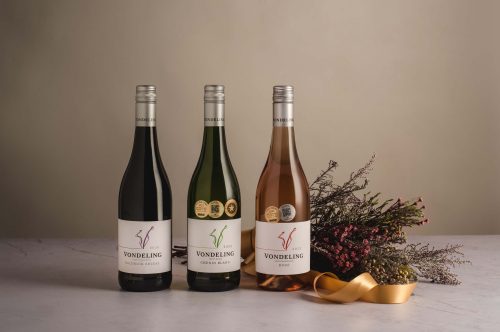
Petit Gift Pack (3 pack option)
R460.00 (incl. VAT)
Option 1: Petit Chenin Blanc 2024 & Rose 2024 & Petit Rouge Merlot 2021 OR Option 2: Petit Chenin Blanc 2024 & Rose 2024 & Baldrick Shiraz 2022 OR Option 3: Sauvignon Blanc 2024 & Rose 2024 & Petit Rouge Merlot 2021 OR Option 4: Sauvignon Blanc 2024 & Rose 2024 & Baldrick Shiraz 2022 Packaged in a sophisticated, branded 3-pack cardboard wine carrier, finished with ribbon & fynbos from the farm. -
 (Cabernet Sauvignon 64% ,Merlot 21%, Cabernet Franc 15%) LIMITED RELEASE Philosophie is a brave endeavor in which we attempt to marry the mind, the heart, and the soil as we celebrate the diversity of Vondeling. THE STORY BEHIND THE LABEL Each year a celebrated artist is recruited to illustrate a rare Paardeberg flower in the medium of their choice. This unique artistic rendition of the chosen flower serves as the flag bearer, not only of the vintage, but also of the unique terroir in which the grapes are grown. These special labels are placed on a curated selection of Vondeling’s finest barrels to create a series of collectable, rare wines. Each bottle is individually numbered within the series. This year, we’ve chosen Monsonia speciosa, an endangered member of the geranium family, which grows in the Paardeberg. Its attractive pink and white petals have earned it, its common name the Butterfly or Umbrella Flower. This year’s beautiful image was done in oil paint, by the renowned Wiltshire-based artist, Emma Haggas – hereby adding emotion to place. VINEYARDS On Vondeling, in a handful of site-specific vineyards, we employ the very finest viticultural and scientific methods to explore the limits of quality grape production. Each vineyard is carefully assessed at the end of the growing season and attentively pruned during the winter months. At bud burst, any shoots which develop poorly are immediately removed. This ensures that the remaining canes are robust with plenty of energy to ensure fertile flowers and uniform berry set. As the grapes develop, only the best bunch per cane is selected and the rest are dropped to the ground. This lowers the load on the vine, thereby removing any stress in the plant and allowing perfect flavour and tannin development. It also diminishes any need for irrigation and helps preserve the grape’s natural acidity. VINIFICATION Once deemed to have reached optimal ripeness the grapes are hand- picked and refrigerated for 24hrs. The bunches are gently destemmed, but the berries are kept intact for individual berry sorting during which any green material and unripe berries are removed. The berries are not pumped, but ferried, via conveyor to open-top fermenters. This reduces the amount of juice exposed to degradation by oxygen. Cold soaking is done at 6 ˚C for a period of 3 days. Cold soaking is a process which facilitates partial degradation of the grape cell wall, to gently extract the flavours and aromatics situated below the surface of the skin. Subtle tannin extraction protects these delicate flavours and promotes colour stability. As the berries slowly come to room temperature, spontaneous fermentation begins due to the presence of natural, ambient yeast. This natural fermentation by multiple yeast strains, is preferable, as it furthers the regional expression of the wine while promoting complexity and character. A cool fermentation temperature slows the rate of fermentation and affords our winemaker adequate time to assess and manipulate the character of the wine, thus unlocking its full potential. Full extraction is ensured by regular punch downs during a two-week ferment. The skins are further macerated post-fermentation for a week before they’re pressed in a traditional basket press. From the press, the wine moves to 300L French Oak barrels for malolactic fermentation. This slow bacterial degradation of the wine’s harsher acidity has the welcome side effect of meshing the oak and natural fruit flavours into a seamless package. Two-thirds of the barrels are new. The wine remains on its yeast and malolactic lees for 14 months before the best 10 barrels are selected. These barrels are blended and returned for an additional 8 months of maturation. Of these 10 barrels only 5 are selected for the final blend. The wine is bottled after 3 months in tank and bottle matured for at least two years before release. TASTING NOTES & CELLARING & FOOD PAIRING The colour is a near-opaque charcoal red with a dense, scarlet hue. The nose has a superb sense of plush black current, wonderfully restrained and balanced by a hint of graphite. At the same time, the delicate floral notes of the Cabernet Franc are seamlessly infused with notes of sweet raspberry, uplifting aniseed and a hint of pencil shavings. The palate has a dense, weighted presence with a persistent finish. The tannins of this powerful wine are quite precise and balance the abundant ripe berry flavours beautifully. Bright notes of cinnamon and vanilla flow through the berry melange and are supported by seamless oak. This wine’s complex character lends itself to richer cuts of meat and dishes redolent with layers of umami-laden flavour. The likes of pan-seared duck, slow-roasted beef and venison goulash are all excellent counterparts, as are posh burgers with all the trimmings and saucy Tournedos Rossini. Accolades 2016 Vintage: 2022 Platter Guide - 4.5 Stars(94 Points) 2017 Vintage: 2023 Platter Guide - 5 Stars (96 Points) 2019 Vintage: 2024 Platter Guide -5 Stars(97 Points) & Category winner (Cape Bordeux Blend) Analysis pH 3.73 Total Acidity 5.5 g/l Residual Sugar 3.7 g/l Alcohol 14.64 % Download tasting notes
(Cabernet Sauvignon 64% ,Merlot 21%, Cabernet Franc 15%) LIMITED RELEASE Philosophie is a brave endeavor in which we attempt to marry the mind, the heart, and the soil as we celebrate the diversity of Vondeling. THE STORY BEHIND THE LABEL Each year a celebrated artist is recruited to illustrate a rare Paardeberg flower in the medium of their choice. This unique artistic rendition of the chosen flower serves as the flag bearer, not only of the vintage, but also of the unique terroir in which the grapes are grown. These special labels are placed on a curated selection of Vondeling’s finest barrels to create a series of collectable, rare wines. Each bottle is individually numbered within the series. This year, we’ve chosen Monsonia speciosa, an endangered member of the geranium family, which grows in the Paardeberg. Its attractive pink and white petals have earned it, its common name the Butterfly or Umbrella Flower. This year’s beautiful image was done in oil paint, by the renowned Wiltshire-based artist, Emma Haggas – hereby adding emotion to place. VINEYARDS On Vondeling, in a handful of site-specific vineyards, we employ the very finest viticultural and scientific methods to explore the limits of quality grape production. Each vineyard is carefully assessed at the end of the growing season and attentively pruned during the winter months. At bud burst, any shoots which develop poorly are immediately removed. This ensures that the remaining canes are robust with plenty of energy to ensure fertile flowers and uniform berry set. As the grapes develop, only the best bunch per cane is selected and the rest are dropped to the ground. This lowers the load on the vine, thereby removing any stress in the plant and allowing perfect flavour and tannin development. It also diminishes any need for irrigation and helps preserve the grape’s natural acidity. VINIFICATION Once deemed to have reached optimal ripeness the grapes are hand- picked and refrigerated for 24hrs. The bunches are gently destemmed, but the berries are kept intact for individual berry sorting during which any green material and unripe berries are removed. The berries are not pumped, but ferried, via conveyor to open-top fermenters. This reduces the amount of juice exposed to degradation by oxygen. Cold soaking is done at 6 ˚C for a period of 3 days. Cold soaking is a process which facilitates partial degradation of the grape cell wall, to gently extract the flavours and aromatics situated below the surface of the skin. Subtle tannin extraction protects these delicate flavours and promotes colour stability. As the berries slowly come to room temperature, spontaneous fermentation begins due to the presence of natural, ambient yeast. This natural fermentation by multiple yeast strains, is preferable, as it furthers the regional expression of the wine while promoting complexity and character. A cool fermentation temperature slows the rate of fermentation and affords our winemaker adequate time to assess and manipulate the character of the wine, thus unlocking its full potential. Full extraction is ensured by regular punch downs during a two-week ferment. The skins are further macerated post-fermentation for a week before they’re pressed in a traditional basket press. From the press, the wine moves to 300L French Oak barrels for malolactic fermentation. This slow bacterial degradation of the wine’s harsher acidity has the welcome side effect of meshing the oak and natural fruit flavours into a seamless package. Two-thirds of the barrels are new. The wine remains on its yeast and malolactic lees for 14 months before the best 10 barrels are selected. These barrels are blended and returned for an additional 8 months of maturation. Of these 10 barrels only 5 are selected for the final blend. The wine is bottled after 3 months in tank and bottle matured for at least two years before release. TASTING NOTES & CELLARING & FOOD PAIRING The colour is a near-opaque charcoal red with a dense, scarlet hue. The nose has a superb sense of plush black current, wonderfully restrained and balanced by a hint of graphite. At the same time, the delicate floral notes of the Cabernet Franc are seamlessly infused with notes of sweet raspberry, uplifting aniseed and a hint of pencil shavings. The palate has a dense, weighted presence with a persistent finish. The tannins of this powerful wine are quite precise and balance the abundant ripe berry flavours beautifully. Bright notes of cinnamon and vanilla flow through the berry melange and are supported by seamless oak. This wine’s complex character lends itself to richer cuts of meat and dishes redolent with layers of umami-laden flavour. The likes of pan-seared duck, slow-roasted beef and venison goulash are all excellent counterparts, as are posh burgers with all the trimmings and saucy Tournedos Rossini. Accolades 2016 Vintage: 2022 Platter Guide - 4.5 Stars(94 Points) 2017 Vintage: 2023 Platter Guide - 5 Stars (96 Points) 2019 Vintage: 2024 Platter Guide -5 Stars(97 Points) & Category winner (Cape Bordeux Blend) Analysis pH 3.73 Total Acidity 5.5 g/l Residual Sugar 3.7 g/l Alcohol 14.64 % Download tasting notes -
 VINEYARDS Made primarily from cold-pressed Merlot, the anchor vineyard for this delicious wine is over 20yrs old. Located on a granite spur in the foothills of the Paardeberg Mountain, the berries are well exposed to sunlight. Exposure to sunlight is essential to eliminate green flavours from the fruit. The soil has a high clay percentage, and this lends softness and volume to the wine. Great care is taken to ensure that the vines do not bear too great a crop or suffer from drought. This is done through green cropping of the vines and micro-irrigation. Both practices help to preserve the natural acidity, freshness and vibrancy of the grape aromas. VINIFICATION Grapes are picked at optimum ripeness in the early hours of the morning before being destemmed and chilled before pressing. This short route, from vine to press, ensures minimal degradation of the fruit aromas and a very moderate extraction of colour. All free-run juice is kept separate from the colour fraction to ensure a deliciously subtle salmon colour. The juice is cold settled to remove any coarseness and fermentation is done in stainless steel tanks. The wine is 100% unoaked. A six-month period of maturation on the yeast lees promotes richness and complexity. TASTING NOTES & CELLARING & FOOD PAIRING The wine has a delightfully delicate, salmon pink colour. It displays a bright bouquet of Turkish delight, raspberry coulis, passion fruit, and taught grapefruit. The palate is well rounded but refreshingly vibrant, packed with red berry flavours, seductive floral undertones, and a pleasant citrus twist. Pair with spicy Thai prawns, grilled Portuguese sardines, or a fresh tomato, feta and pomegranate salad. Accolades 2023 Platter’s Guide-3.5 stars (85Pts) 2023 Vintage: 2023 Gold Wine Awards-Gold 2023 Vitis Vinifera - Gold 2022 Vintage: 2022 Michelangelo - Gold 2022 Gilbert Gaillard -Gold 2021 Vintage: 2021 Michelangelo - Gold 2021 Vitis Vinifera - Gold 2021 Rose Rocks - Gold 2020 Vintage: 2020 Rose Rocks - Gold 2020 Vitis Vinifera Awards - Gold Analysis pH 3.47 Total Acidity 5.5 g/l Residual Sugar 3.6 g/l Alcohol 12.57 % Download Tasting Sheet
VINEYARDS Made primarily from cold-pressed Merlot, the anchor vineyard for this delicious wine is over 20yrs old. Located on a granite spur in the foothills of the Paardeberg Mountain, the berries are well exposed to sunlight. Exposure to sunlight is essential to eliminate green flavours from the fruit. The soil has a high clay percentage, and this lends softness and volume to the wine. Great care is taken to ensure that the vines do not bear too great a crop or suffer from drought. This is done through green cropping of the vines and micro-irrigation. Both practices help to preserve the natural acidity, freshness and vibrancy of the grape aromas. VINIFICATION Grapes are picked at optimum ripeness in the early hours of the morning before being destemmed and chilled before pressing. This short route, from vine to press, ensures minimal degradation of the fruit aromas and a very moderate extraction of colour. All free-run juice is kept separate from the colour fraction to ensure a deliciously subtle salmon colour. The juice is cold settled to remove any coarseness and fermentation is done in stainless steel tanks. The wine is 100% unoaked. A six-month period of maturation on the yeast lees promotes richness and complexity. TASTING NOTES & CELLARING & FOOD PAIRING The wine has a delightfully delicate, salmon pink colour. It displays a bright bouquet of Turkish delight, raspberry coulis, passion fruit, and taught grapefruit. The palate is well rounded but refreshingly vibrant, packed with red berry flavours, seductive floral undertones, and a pleasant citrus twist. Pair with spicy Thai prawns, grilled Portuguese sardines, or a fresh tomato, feta and pomegranate salad. Accolades 2023 Platter’s Guide-3.5 stars (85Pts) 2023 Vintage: 2023 Gold Wine Awards-Gold 2023 Vitis Vinifera - Gold 2022 Vintage: 2022 Michelangelo - Gold 2022 Gilbert Gaillard -Gold 2021 Vintage: 2021 Michelangelo - Gold 2021 Vitis Vinifera - Gold 2021 Rose Rocks - Gold 2020 Vintage: 2020 Rose Rocks - Gold 2020 Vitis Vinifera Awards - Gold Analysis pH 3.47 Total Acidity 5.5 g/l Residual Sugar 3.6 g/l Alcohol 12.57 % Download Tasting Sheet -

(Limited to 15 cases only)
(80% Chardonnay & 20% Pinotage) VINEYARDS Vondeling Rurale is comprised of 80% Chardonnay and 20% Pinotage. The Chardonnay grapes originate from a single block, located on a south-west facing slope on the decomposed granite soils of the Paardeberg Mountain. The Pinotage grapes are grown on our lower valley slopes in soils comprised of gravel and clay. Typically, the Pinotage grapes add weight and texture. Unlike Mèthode Cap Classique, Mèthode Ancestrale grapes are harvested with a potential alcohol of 12% (rather than 9%). This promotes a fuller, more rounded pallet with superior fruit expression without compromising on natural vibrancy and freshness. VINIFICATION Natural fermentation begins in a stainless-steel tank and when only a small, but critical amount of sugar remains, the fermenting wine is bottled and capped. Bottling must be done at the precise moment when there is enough remaining sugar to create a healthy, vibrant mousse, but not so much as to cause the bottles to explode. This single, continuous fermentation, using fruit which is approximately three weeks riper than the base wine used to make Mèthode Cap Classique, is what makes Mèthode Ancestrale unique. The wine is matured on its lees for 3 years before riddling and disgorging. Autolysis of the yeast cells increases richness, palate weight and creaminess to the wine. After being hand riddled over a one-month period, it is disgorged and topped using our flagship white blend, Babiana from the 2013 vintage, as an alternative to liqueur d’expedition. The name Rurale is the original name for what was later recognized by the French A.O.C as Mèthode Ancestrale. We love the implication that this is an uncomplicated, yet pure expression of both the grape and its origins. Rurale was the first recognized Mèthode Ancestrale to be produced in South Africa and remains the leaded in this category. Vondeling was instrumental in drafting the technical description, which allowed this new category to be recognized in 2014. It is a highly labour-intensive way to produce sparkling wine, and for this reason, only 3300 bottles were produced. All grapes are grown and vinified on Vondeling Farm and Cellar TASTING NOTES & CELLARING & FOOD PAIRING The wine displays a pale straw colour typical of bubbly that has enjoyed the benefits of extended lees maturation. Tiny, pearl-string bubbles and fine mousse abound. Beautiful aromas of lavender honey, lime, crisp apple with freshly baked pastry and toasted almonds on the nose. The palate is bright and zippy with vibrant acidity and a soft, creamy mouthfeel. Fresh apple appears again along with pears, confected lemon and a long, rich, lingering after taste. Rurale can be paired with smoked salmon, fennel roasted trout or fresh oysters with a squeeze of lemon, salt, and pepper. ACCOLADES 2018 Vintage: 2021 SA Sparkling Wine Championships – Double Gold 2021 Michelangelo- Gold 2022 Platter Wine Guide 2020 – 4,5 stars (93pts) ANALYSIS pH 3.37 Total Acidity 8.0 g/l Residual Sugar 4.7 g/l Alcohol 11.94 % DOWNLOAD TASTING NOTE -
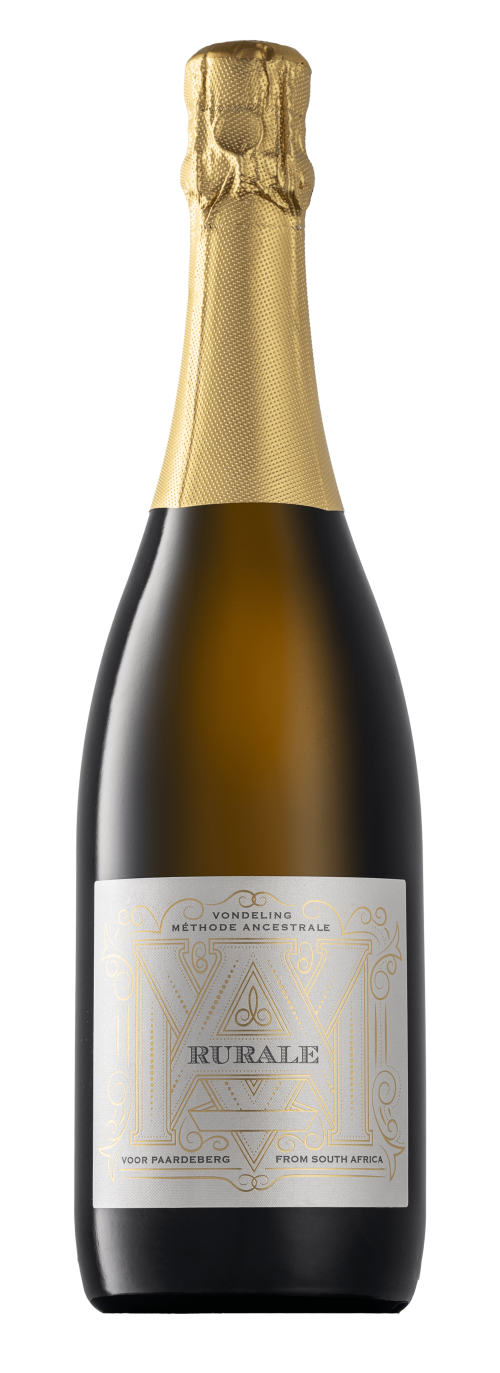 (100% Chardonnay) VINEYARDS Vondeling Rurale is comprised of 100% Chardonnay . The Chardonnay grapes originate from a single block, located on a south-west facing slope on the decomposed granite soils of the Paardeberg Mountain. Unlike Mèthode Cap Classique, Mèthode Ancestrale grapes are harvested with a potential alcohol of 12% (rather than 9%). This promotes a fuller, more rounded pallet with superior fruit expression without compromising on natural vibrancy and freshness. VINIFICATION Natural fermentation begins in a stainless-steel tank and when only a small, but critical amount of sugar remains, the fermenting wine is bottled and capped. Bottling must be done at the precise moment when there is enough remaining sugar to create a healthy, vibrant mousse, but not so much as to cause the bottles to explode. This single, continuous fermentation, using fruit which is approximately three weeks riper than the base wine used to make Mèthode Cap Classique, is what makes Mèthode Ancestrale unique. The wine is matured on its lees for 3 years before riddling and disgorging. Autolysis of the yeast cells increases richness, palate weight and creaminess to the wine. After being hand riddled over a one-month period, it is disgorged and topped using our flagship white blend, Babiana from the 2013 vintage, as an alternative to liqueur d’expedition. The name Rurale is the original name for what was later recognized by the French A.O.C as Mèthode Ancestrale. We love the implication that this is an uncomplicated, yet pure expression of both the grape and its origins. Rurale was the first recognized Mèthode Ancestrale to be produced in South Africa and remains the leader in this category. Vondeling was instrumental in drafting the technical description, which allowed this new category to be recognized in 2014. It is a highly labour-intensive way to produce sparkling wine, and for this reason, only 2750 bottles were produced. All grapes are grown and vinified on Vondeling Farm and Cellar. TASTING NOTES & CELLARING & FOOD PAIRING The wine displays a pale straw colour typical of bubbly that has enjoyed the benefits of extended lees maturation. Tiny, pearl-string bubbles and fine mousse abound. Beautiful aromas of lavender honey, lime, crisp apple with freshly baked pastry and toasted almonds on the nose. The palate is bright and zippy with vibrant acidity and a soft, creamy mouthfeel. Fresh apple appears again along with pears, confected lemon and a long, rich, lingering after taste. Rurale can be paired with smoked salmon, fennel roasted trout or fresh oysters with a squeeze of lemon, salt, and pepper. Accolades: 2018 Vintage: 2021 SA Sparkling Wine Championships – Double Gold 2021 Michelangelo- Gold 2022 Platter Wine Guide 2020 – 4,5 stars (93pts) Analysis: pH 3.42 Total Acidity 7.2 g/l Residual Sugar 1.4 g/l Alcohol 11.36 % Download Tasting Sheet
(100% Chardonnay) VINEYARDS Vondeling Rurale is comprised of 100% Chardonnay . The Chardonnay grapes originate from a single block, located on a south-west facing slope on the decomposed granite soils of the Paardeberg Mountain. Unlike Mèthode Cap Classique, Mèthode Ancestrale grapes are harvested with a potential alcohol of 12% (rather than 9%). This promotes a fuller, more rounded pallet with superior fruit expression without compromising on natural vibrancy and freshness. VINIFICATION Natural fermentation begins in a stainless-steel tank and when only a small, but critical amount of sugar remains, the fermenting wine is bottled and capped. Bottling must be done at the precise moment when there is enough remaining sugar to create a healthy, vibrant mousse, but not so much as to cause the bottles to explode. This single, continuous fermentation, using fruit which is approximately three weeks riper than the base wine used to make Mèthode Cap Classique, is what makes Mèthode Ancestrale unique. The wine is matured on its lees for 3 years before riddling and disgorging. Autolysis of the yeast cells increases richness, palate weight and creaminess to the wine. After being hand riddled over a one-month period, it is disgorged and topped using our flagship white blend, Babiana from the 2013 vintage, as an alternative to liqueur d’expedition. The name Rurale is the original name for what was later recognized by the French A.O.C as Mèthode Ancestrale. We love the implication that this is an uncomplicated, yet pure expression of both the grape and its origins. Rurale was the first recognized Mèthode Ancestrale to be produced in South Africa and remains the leader in this category. Vondeling was instrumental in drafting the technical description, which allowed this new category to be recognized in 2014. It is a highly labour-intensive way to produce sparkling wine, and for this reason, only 2750 bottles were produced. All grapes are grown and vinified on Vondeling Farm and Cellar. TASTING NOTES & CELLARING & FOOD PAIRING The wine displays a pale straw colour typical of bubbly that has enjoyed the benefits of extended lees maturation. Tiny, pearl-string bubbles and fine mousse abound. Beautiful aromas of lavender honey, lime, crisp apple with freshly baked pastry and toasted almonds on the nose. The palate is bright and zippy with vibrant acidity and a soft, creamy mouthfeel. Fresh apple appears again along with pears, confected lemon and a long, rich, lingering after taste. Rurale can be paired with smoked salmon, fennel roasted trout or fresh oysters with a squeeze of lemon, salt, and pepper. Accolades: 2018 Vintage: 2021 SA Sparkling Wine Championships – Double Gold 2021 Michelangelo- Gold 2022 Platter Wine Guide 2020 – 4,5 stars (93pts) Analysis: pH 3.42 Total Acidity 7.2 g/l Residual Sugar 1.4 g/l Alcohol 11.36 % Download Tasting Sheet -
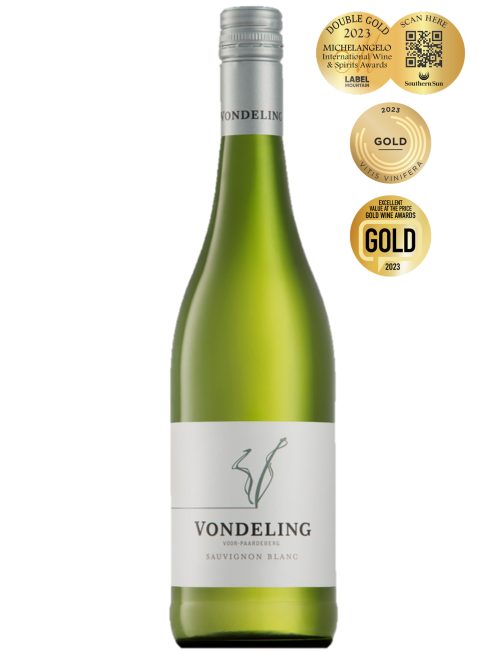
VINEYARDS
The grapes used to make this wine come from adjacent old vineyards planted in 1981 and 1984 respectively. For obvious reasons the one vineyard is called the Spice Block and the other the Long Block. Yields are rarely above 7t/ha and therefore naturally produce wines of structure and superior concentration. Our soils consist primarily of deep, well-weathered granite with moderate amounts of clay and iron. Such soils elevate the aromatics and promote finesse in the wine.
VINIFICATION
Grapes are picked in the cool, early hours of the morning then packed into a cold room for further cooling. Once the grapes are below 10°C they are gently destemmed, crushed and pressed speedily to tank. During this process, the sensitive Sauvignon Blanc juice is protected from oxidative degradation, through the judicious application of dry ice pellets. These pellets form an “insulation blanket” of carbon dioxide gas above the juice. The initial, free-run juice and press juice are managed separately, according to their character. The juice is cold settled for 48 hours before it is racked from its sediments and inoculated with pure yeast cultures. Cold fermentation at 12°C locks in freshness and ensures an intense tropical fruit bouquet. After fermentation, the wine is kept on the gross lees for 4 months. This practice adds weight and texture to the palate. TASTING NOTES & CELLARING & FOOD PAIRINGThe wine is crystal clear with a slight green edge. It displays an aromatic kaleidoscope, rich with perfumed peach, white pear, passion fruit and lime. These wonderful aromas prevail on the palate with added guava, pineapple, potpourri and nettle. The roundness of the palate is perfectly balanced by a steely mineral zest and enjoyable long finish. Enjoy chilled with fresh sourdough bread and soft cheeses or lime drizzled game fish.
Accolades 2020 Vintage: 2020 Gilbert & Gaillard International Challenge - Gold 2023 Vintage: 2023 Michelangelo- Double Gold 2023 Gold Wine Awards- Gold 2023 Vitis Vinifera- Gold Analysis pH 3.33 Total Acidity 5.8 g/l Residual Sugar 4.5 g/l Alcohol 12.78 % Download Tasting Sheet 2023 -
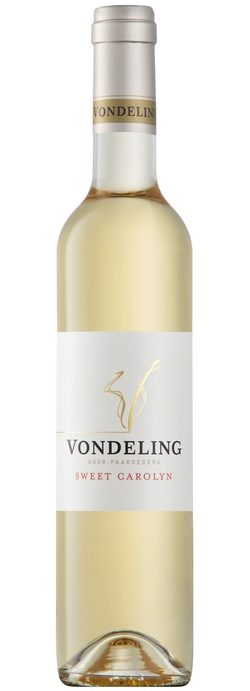 (100% Muscat de Frontignan) VINEYARDS This wine is made from a single vineyard of Muscat d’Frontignan. The winemaking begins in the vineyard. When the acidity and sugar are in perfect harmony, the stem of each bunch is individually crimped to isolate the bunch from the vine. The crimping process stops the supply of water to the bunch, causing the berries to desiccate on the vine. Crimping is done before the grapes are 100% ripe and still high in natural acidity. The crimping process concentrates the sugar and the acidity of the berries and takes up to two weeks. The grapes are naturally protected from the sun by the vine canopy and air movement across the berries stops moulds and fungi from forming while they are drying. Finally, the fruit is ready for picking. VINIFICATION The dried grapes are hand-picked and chilled overnight. They are then destemmed, but not crushed, directly to open top fermenters. Here the berries are fermented much like a red wine, with periodic punch downs, to extract all the syrupy juice from inside. This method adds structure to the wine and the light tannins help to preserve fruity freshness. After approximately one week on the skins, they are pressed, and fermentation is completed in tank. Fermentation stops naturally when the combination of high acidity, increasing alcohol and concentrated sugar finally becomes too inhibitory for the yeast. The wine is aged for 11 months on the gross lees before it is bottled. TASTING NOTES & CELLARING & FOOD PAIRING The wine displays a golden to light amber colour. It has a perfumed nose of bright pineapple, ripe apricot, honeyed marmalade and seductive rose petal. These heady aromas are supported by orange blossom, jasmine and wild rosemary. The nose carries through to the taste, where the mouth-watering sweetness is cut by a tangy acidity, which ensures a persistent and refreshing finish. This is a naturally fermented and unfortified wine, and allows for many delightful treats, which may incl. savoury duck liver pate, sweet spice-laced puddings and traditional soft cheeses. Serve chilled and don’t wait for dessert. Accolades 2022 Platter’s Guide – 4.5 Stars
(100% Muscat de Frontignan) VINEYARDS This wine is made from a single vineyard of Muscat d’Frontignan. The winemaking begins in the vineyard. When the acidity and sugar are in perfect harmony, the stem of each bunch is individually crimped to isolate the bunch from the vine. The crimping process stops the supply of water to the bunch, causing the berries to desiccate on the vine. Crimping is done before the grapes are 100% ripe and still high in natural acidity. The crimping process concentrates the sugar and the acidity of the berries and takes up to two weeks. The grapes are naturally protected from the sun by the vine canopy and air movement across the berries stops moulds and fungi from forming while they are drying. Finally, the fruit is ready for picking. VINIFICATION The dried grapes are hand-picked and chilled overnight. They are then destemmed, but not crushed, directly to open top fermenters. Here the berries are fermented much like a red wine, with periodic punch downs, to extract all the syrupy juice from inside. This method adds structure to the wine and the light tannins help to preserve fruity freshness. After approximately one week on the skins, they are pressed, and fermentation is completed in tank. Fermentation stops naturally when the combination of high acidity, increasing alcohol and concentrated sugar finally becomes too inhibitory for the yeast. The wine is aged for 11 months on the gross lees before it is bottled. TASTING NOTES & CELLARING & FOOD PAIRING The wine displays a golden to light amber colour. It has a perfumed nose of bright pineapple, ripe apricot, honeyed marmalade and seductive rose petal. These heady aromas are supported by orange blossom, jasmine and wild rosemary. The nose carries through to the taste, where the mouth-watering sweetness is cut by a tangy acidity, which ensures a persistent and refreshing finish. This is a naturally fermented and unfortified wine, and allows for many delightful treats, which may incl. savoury duck liver pate, sweet spice-laced puddings and traditional soft cheeses. Serve chilled and don’t wait for dessert. Accolades 2022 Platter’s Guide – 4.5 Stars2017 Vintage:
2020 Platter’s Guide – 4.5 Stars 2018 James Suckling SA Report 90 points
Analysis pH 3.38 Total Acidity 6.4 g/l Residual Sugar 177.6 g/l Alcohol 12.38 % Download Tasting Sheet

